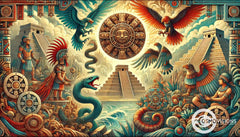Explore the Divine World of Aztec Goddesses: A Comprehensive List of Important Aztec Gods and Goddesses
Posted by Massimiliano Geraci

Are you curious about the ancient gods and goddesses who once ruled over the vibrant world of the Aztecs? Many people find themselves drawn to these powerful deities but struggle with where to start their journey into Aztec mythology.
The Aztecs, a group with deep roots in central Mexico, worshipped various supernatural beings that played crucial roles in their daily lives and cosmic understanding.
One fascinating fact about this rich tradition is that the city of Tenochtitlan was established based on a vision—an eagle clutching a snake while perched atop a cactus—guided by their revered god Huitzilopochtli.
This article will guide you through an enlightening exploration of important Aztec gods and goddesses, shedding light on both well-known and lesser-known deities. We'll dive deep into their stories and symbols from Coatlicue, the earth mother with her skirt of serpents, to Quetzalcoatl, the feathered serpent creator god.
Explore the Divine World of Aztec Goddesses: A Comprehensive List of All the Aztec Gods and Goddesses. Get ready for an adventure into the divine.
Key Takeaways
Aztecs worshipped many gods, each ruling over different aspects of life. They believed in maintaining balance with the divine through rituals and human sacrifices.
Goddesses like Coatlicue and Chicomecoatl played vital roles, symbolizing life, death, and agriculture. Their stories teach about nature's power and the importance of balance.
Important deities like Huitzilopochtli guided the Aztecs in war and were central to their mythology. Rituals for these gods aimed to secure victory and cosmic harmony.
Human sacrifice was a major part of worship, believed to please the gods ensuring prosperity for society. Each ceremony had deep meanings beyond mere ritual acts.
Today, ancient Aztec beliefs live on in Mexican culture through festivals, art, and traditions that honor old gods while blending past with present practices.
Unveiling the Divine: Exploring the Pantheon of Important Aztec Goddesses and Gods
The Aztec pantheon is full of powerful deities, each ruling over different aspects of life and the cosmos. Tlaloc, an important Aztec god, brings rain to nourish crops, while Chalchiuhtlicue governs rivers and lakes, ensuring fertility across the lands.
These gods were central to the Aztec religion, deeply influencing how people lived their daily lives. Through ceremonies and offerings, including human sacrifice, Aztecs sought to maintain harmony with these divine forces.
Among these deities, female goddesses like Coatlicue, the mother of gods who donned a skirt made of serpents, held immense respect and fear. Her story tells much about creation and destruction in Aztec mythology.
Other important figures include Xiuhtecuhtli, master of fire; Huitzilopochtli, the patron deity and warrior god guiding the Aztec empire; Quetzalcoatl; Tezcatlipoca with his smoking mirror symbolism; Mictlantecuhtli overseeing the underworld; and Chicomecoatl ensuring maize abundance.
Each had festivals dedicated specifically for worshiping them through rich rituals that connected humans with celestial realms.
Introduction to Aztec Mythology and Religion
Aztec mythology forms the backbone of Aztec religious practices, deeply rooted in the history and culture of Central Mexico’s Nahuatl-speaking groups. This ancient civilization drew its strength and identity from a rich tapestry of tales and legends, each rendering life to an array of gods and goddesses that commanded every aspect of their world.
From the creation myths that tell the story of their journey from Aztlan to the establishment of their great city Tenochtitlan, guided by Huitzilopochtli, their deity warrior, these narratives served not only as spiritual guidance but also as foundational pillars for societal norms and customs.
Central to Aztec worship were entities such as Tlaloc, god of rain; Coatlicue, mother of gods; Quetzalcoatl, the feathered serpent creator god; and Huitzilopochtli, the most important Aztec god of war, along with many others who shaped the cosmos according to Aztec beliefs.
Each deity embodied specific natural forces or aspects of human existence, making religion an omnipresent force in everyday life. Through ceremonies filled with pageantry—and at times sacrifices—Aztecs sought balance within this divine order while appeasing deities responsible for nourishing crops or delivering victory in battle.
This complex network between earthy and celestial realms showcases not just a religion but a comprehensive way through which ancient Mexicans interpreted their place in a vibrant yet uncertain universe.
Aztec mythology: The foundation of Aztec religious practices
Aztec mythology shaped their religious practices deeply. They worshipped over 200 gods and goddesses, each ruling over different aspects of life and the natural world. This rich pantheon included major deities like Huitzilopochtli, the Aztec god of war, and Quetzalcoatl, the feathered serpent creator god.
These stories weren't just tales; they were the heart of Aztec society. Every ritual and ceremony aimed to honor these divine beings. People believed that they maintained cosmic balance by appeasing the gods through offerings and human sacrifices.
This belief system came from a long history rooted in Mesoamerican culture. The Aztecs thought their ancestors hailed from Aztlan in the north, guided by Huitzilopochtli to their new home where they built a mighty empire.
Creation myths like the Five Suns described cycles of birth, death, and rebirth that influenced every aspect of Aztec life, from daily activities to grand ceremonies in their capital.
Next up: we'll explore some important gods and goddesses at the center of worship.
- Important Aztec gods and goddesses: The central figures in worship
The Aztec pantheon was rich and diverse, made up of many powerful gods and goddesses. Each deity had a specific role, shaping life and the afterlife for the Aztec people. Huitzilopochtli stood as the sun god and war leader, guiding warriors in battle.
Quetzalcoatl, known as the feathered serpent, brought wisdom and was a creator god. Tezcatlipoca wielded power over night and sorcery, always watching from his smoking mirror.
Goddesses held great importance too. Coatlicue wore her serpent skirt with dignity as the mother of gods. Chicomecoatl ensured maize grew to feed everyone, symbolizing fertility and abundance.
Chalchiuhtlicue ruled over waters, offering nourishment to land and people alike. Rituals honored these deities to keep balance in the world. Sacrifices were made to please them so they would look favorably upon the Aztecs.
Role in Aztec society: How mythology influenced the Aztec way of life
Aztec mythology shaped every part of life in Aztec culture. Gods and goddesses influenced how people grew food, fought wars, and worshiped. Festivals like Ochpaniztli honored the goddess Tlazolteotl with activities such as cleaning and dancing to seek purity and forgiveness.
These rituals were key to keeping the gods happy, ensuring rain fell, crops grew, and health thrived among the people.
Human sacrifice played a big role in connecting the Aztecs with their deities. They believed offering lives appeased powerful beings like Huitzilopochtli, ensuring victory in battles and balance in nature.
This practice showed deep devotion to their beliefs, making religion central to maintaining order within Aztec society. Now let's uncover more about specific Aztec gods and goddesses seen as vital forces of nature and creation by moving into detailed explorations of their powers.

Decoding the Powers and Symbols of Aztec Goddesses
Coatlicue wears a skirt of serpents and stands as the powerful mother of gods. She symbolizes life and death, showing her role in creating and ending life. Her image teaches about the balance of nature.
Chalchiuhtlicue controls running water and brings fertility. She protects women and children, showing how Aztecs valued family. Chicomecoatl feeds people with maize, highlighting the importance of agriculture in Aztec society.
These goddesses had festivals in their honor to keep balance in the world.
Each goddess carries unique symbols that tell stories of power, care, and nature's cycles. These symbols represent the values held by ancient peoples—respect for motherhood, fertility, water's gift, and earth's bounty.
Coatlicue: The serpent skirted mother of gods
Coatlicue stands as a towering figure in Aztec mythology, embodying fertility and life itself. She wears a skirt made of serpents, marking her as the powerful mother of gods, including the mighty Huitzilopochtli, god of sun and war.
Her image captures the essence of creation and destruction, symbolizing the cycle of life that was central to Aztec belief.
This deity’s presence weaves through tales that highlight both nurturing and fearsome aspects. As a goddess associated with the earth, Coatlicue plays an essential role in agricultural rituals and is revered across realms touching on religion and art lovers alike.
Her story is not just about power but also about balance—between humanity and nature—and serves as a fundamental narrative within the myths of the most important Aztec gods shaping spirituality today.
Chalchiuhtlicue: Goddess of running water and fertility
Chalchiuhtlicue, the Aztec goddess of fresh water and fertility, held a crucial role in Aztec life. Her powers touched every stream, lake, and river, bringing life to crops and people alike.
As the patroness of women and children, her care extended beyond nature to human lives. Her worship reached far and wide across the empire, showing her vast importance. Rituals dedicated to her often involved human sacrifices showing deep respect for her might.
Her influence did not end with nature; it also shaped culture and society among the Aztecs. Chalchiuhtlicue's symbol was essential to festivals celebrating water's gift to agriculture.
Stories say she watched over childbirth, too, offering protection in moments most sacred to families. Next up is Chicomecoatl, another powerful figure within this divine pantheon who brings forth abundance from the fields.
Chicomecoatl: The maize goddess and her significance in Aztec culture
Chicomecoatl, the goddess of maize, played a huge role in Aztec life. She brought people food by making maize grow. This was key since maize was what most Aztecs ate every day. Chicomecoatl wasn't just about food; she also stood for fertility and growth in farming.
Each year, big festivals honored her to make sure crops were good.
Her image appears frequently in Aztec art, telling us she was super important. For the Aztecs, growing crops linked humans with nature's power. By worshiping Chicomecoatl, they showed respect to this cycle of life that kept their community strong and fed.
Her story is a big part of understanding how religion and daily life mixed together for the Aztecs.
The Pantheon of Aztec Gods: War, Creation, and the Underworld
Huitzilopochtli stood tall as the Aztec sun god and the main god of the Aztecs. He ruled over war and guided his people with fierce protection. His power fueled their battles, making him a central figure in their stories and prayers.
As the sun moved across the sky, it mirrored his journey, battling darkness to bring dawn each day.
Quetzalcoatl, known as the feathered serpent, wove creation into existence with wisdom and wind under his wings. This creator deity shaped the world and its inhabitants with a gentle hand, contrasting sharply with Huitzilopochtli’s might.
Legends say he crafted humans by sprinkling his own blood on bones gathered from the underworld.
Tezcatlipoca brought mystery into this mix of gods. With a mirror that smoked darkness, he commanded magic and ruled nights when secrets unfold under moonlight’s watchful eye. Often seen clashing with Quetzalcoatl, Tezcatlipoca’s influence stretched deep into tales whispering of chaos yet also guarding against it in balance’s tight dance.
These deities—guardians of different realms—drew lines between life’s forces: creation against destruction, light dueling shadow, life met by death at journeys’ end beneath Mictlantecuhtli’s gaze in the chilling depths where myths find their ending—and beginnings too.
Huitzilopochtli: The patron god of the Aztec empire and god of war
The Aztecs built their great city, Tenochtitlan, following a vision guided by Huitzilopochtli, the Aztec sun god and god of war. He led them to an island in Lake Texcoco where they saw an eagle on a cactus with a snake in its mouth.
This sign meant it was the place for their home. Huitzilopochtli was not just any deity; he was the protector of the Aztec empire. People respected him as one of the most important gods.
This god played a huge role in ceremonies and battles. Imagine warriors ready for combat, praying to Huitzilopochtli for strength and victory. They believed he fed on enemies' hearts, making human sacrifice a key part of worshiping him.
These acts kept harmony in the universe and ensured the sun rose each day. Rituals were important to many other Aztec gods, too, but none demanded such fierce devotion as Huitzilopochtli did from his followers.

Quetzalcoatl: The feathered serpent creator god
Shifting from the warrior spirit of Huitzilopochtli, we meet Quetzalcoatl. This deity is a feathered serpent, a symbol of light, life, and wisdom. Quetzalcoatl is also associated with the planet Venus, symbolizing his connection to the evening and morning stars. He rules over the West and is a key figure in Aztec legends.
Quetzalcoatl brings together the earth and sky. His image has roots in ancient tales that date back before the Aztecs to civilizations like the Toltec. People saw him as a creator god who played an important role in religion and mythology.
This powerful god’s story encourages us to see how life can rise from death.
Tezcatlipoca: The smoking mirror god of the night and sorcery
Tezcatlipoca ruled the night sky and controlled the domain of sorcery with his smoking mirror, an ancient symbol showing his power to see everything. Known as a god who could change fate, he played a huge role in Aztec beliefs about providence and darkness.
His image often features a missing foot, telling us of his deep connection to both the earth beneath our feet and mysterious underworld realms.
This deity wasn't just about fear or mystery; Tezcatlipoca's dual nature also meant creation and destruction were in his hands. He embodied life's contradictions—showing that even gods find balance between order and chaos.
As lord of the North, this important Aztec deity defined many aspects of how the Aztecs viewed their world and their place within it. Moving to rituals and worship shows how deeply these beliefs influenced everyday life.
Rituals and Worship: Connecting the Aztecs with the Divine
Aztecs held grand ceremonies to connect with the gods. They believed these acts kept the universe in balance. Their capital was a hub for worship, where priests performed human sacrifices as the ultimate offering.
This sacred act aimed to appease the gods and secure prosperity for their people. Such rituals painted a vivid picture of Aztec devotion, symbolizing the themes of death and rebirth prevalent in their mythology.
Festivals like Ochpaniztli paid homage to powerful goddesses such as Tlazolteotl. During this time, people cleaned their homes, danced in streets adorned with flowers, and carried out acts of penance.
These activities showed respect and love for deities governing fertility and renewal. Aztecs expressed deep spirituality and an enduring connection with celestial beings overseeing life’s cycles through these practices.
Human sacrifice: The ultimate offering to appease the gods
Human sacrifice was a key part of Aztec religion. People thought it pleased the gods and kept the world in balance. The Aztecs held grand rituals in their capital, where they offered human lives to the deities.
This act showed deep respect and fear towards their powerful gods.
Chalchiuhtlicue, the goddess who ruled over water and childbirth, and Tlaloc, the rain god, received sacrifices during special festivals. These events highlighted their importance in providing fertility and nourishment to the land.
Sacrifice was a way for Aztecs to connect with divine forces, hoping for blessings and protection from natural disasters.
Ritual significance: How ceremonies ensured cosmic balance
Moving from the topic of human sacrifice, Aztec ceremonies played a critical role in maintaining cosmic balance. These rituals were vital for the harmony between humans, gods, and nature.
The Aztecs believed that such events helped keep the universe in order and ensured the sun would rise each day. They saw themselves as part of a larger cycle and their actions, especially during these ceremonies, as essential to keeping everything running smoothly.
Festivals honoring different goddesses and gods involved specific rituals like cleaning, dancing, and sometimes even offering sacrifices. These were not just about worship but also about ensuring the fertility of the land, success in war, and overall prosperity.
They aimed to align themselves with cosmic forces through practices tied to their calendar and natural cycles. These acts were crucial for survival in their worldview—every chant sung or dance performed had deep significance far beyond mere performance; it was an enactment of faith playing out on both earthly and divine stages.
Aztec religious ceremonies: Worship practices in the Aztec capital
In the heart of the Aztec capital, worship practices were vibrant and full of life. Priests led ceremonies with great care, honoring powerful gods and goddesses like Huitzilopochtli and Coatlicue.
These events often took place in massive temples painted red to symbolize blood, an important element in their rituals. People came from around to see human sacrifices offered to appease the deities.
This act was believed to ensure cosmic balance and prosperity for their society.
Music filled the air during these sacred gatherings as drums beat rhythmically and conch-shell trumpets sounded off. Dancers wearing elaborate costumes moved in precise patterns, telling stories of creation, war, and renewal that connected them deeply with the divine realm.
Every ceremony was a vivid reminder of how central religion played in everyday life among the Aztecs.

Tracing the Influence of Aztec Religion in Modern Mexican Culture
Aztec gods and goddesses still show up in today's Mexican celebrations. Many people honor these ancient figures with dances, music, and stories. The Day of the Dead is a big event where you can see Aztec beliefs in action.
Skulls and marigolds are everywhere, just like they were in Aztec times to celebrate life and death.
Sacred sites from the Aztec era are part of Mexico’s rich heritage. People visit these places to learn and feel connected to their history. Artists find inspiration in the powerful symbols of Aztec deities, painting them with bright colors that bring old myths back to life.
Even movies and books use tales of gods like Quetzalcoatl or Xolotl to tell new stories mixed with tradition. Through all this, the spirit of Aztec mythology keeps shaping modern Mexican culture.
Aztec gods in contemporary Mexican traditions
In Mexico today, traditions keep the stories of ancient gods alive. People mix these old beliefs with modern practices. They celebrate days that honor Aztec deities through festivals and rituals.
Artists use images of gods like Quetzalcoatl and Huitzilopochtli in their work, showing the power and importance of these figures in Mexican heritage.
Families share tales of goddesses such as Coatlicue and Chalchiuhtlicue to teach life, nature, and history lessons. This keeps the culture strong and connects Mexicans to their past.
Schools might talk about the god of maize, Chicomecoatl, during harvest time to show how old traditions shape today's customs.
The legacy of Aztec mythology in modern folklore and celebrations
Aztec gods leave their mark on today's Mexican traditions, weaving ancient stories into the modern fabric of life. These timeless myths find new breath in festivals and ceremonies, honoring age-old goddesses with joy and reverence.
From city streets to rural landscapes, echoes of Coatlicue, the serpent-skirted mother, remind us of Earth's power and nurturing spirit.
People gather yearly to perform rituals that mirror those performed centuries ago, celebrating the maize goddess Chicomecoatl with dances and food offerings. Such practices highlight a continuous thread linking present to past, demonstrating respect for forces greater than ourselves.
These enduring connection shapes celebrations and an ongoing dialogue with history—a testament to the vitality of Aztec mythology in today’s cultural panorama.
Preservation of Aztec religious sites and their role in Mexican heritage
Keeping Aztec religious sites safe is key for Mexican heritage. These places show us the beliefs and practices of the Aztec civilization. They add to the rich culture and history of Mexico.
By protecting these ancient spots, people today can appreciate and understand Mexico's deep religious past.
These historic locations let us see how important gods and goddesses were in daily Aztec life. Sites dedicated to powerful deities like the god of the sun or lord of the underworld tell stories from centuries ago.
They connect Mexicans to their ancestors' spiritual world, keeping traditions alive in modern times. Through preservation, everyone can learn about these crucial aspects of Mexican identity.
Exploring Lesser-Known Aztec Deities: Beyond the Main Gods and Goddesses
Xipe Totec, known as the flayed god, brings life and new beginnings from death's ashes. He wears human skin to symbolize rebirth after destruction. This deity teaches us about nature's cycle: life always follows death.
Xipe Totec plays a vital role in understanding that end is just a start of something new.
Mictlantecuhtli rules over the underworld, guiding souls on their journey after death. His domain is a reminder that all living things must face an ending. But he also ensures safe passage for those traveling through his realm, proving there’s guidance and protection even in darkness.
Xolotl stands beside his brothers with unique traits—a dog-headed figure lighting up paths with lightning bolts. Unlike others feared for ties to the underworld, Xolotl reminds us of loyalty and being true to our path despite challenges.
Each god—from fertility and renewal by Xipe Totec to guidance through Mictlantecuhtli—shows different sides of existence beyond what we see daily.
- Xipe Totec: The flayed god of fertility and renewal
This god, Xipe Totec, brings new beginnings and earth's bounty. He rules over the seasons, making sure crops grow strong. His image is unique - a figure without skin - to show us the importance of rebirth.
Just like old plants must die for new ones to sprout, his appearance tells a story of renewal.
Worshipers gave offerings to keep him pleased, hoping for fertile lands and good harvests. They painted statues red to echo his flayed appearance. This act connected them deeply with cycles of growth and regeneration.
Next up: exploring Mictlantecuhtli's dark domain as the lord of the underworld.
Mictlantecuhtli: Lord of the underworld and the dead
Mictlantecuhtli rules the underworld, a place for those who die of natural causes. He is a powerful Aztec god of death. Alongside Mictecacihuati, he watches over the dead. Their realm is not just a place of darkness but also an essential part of life's cycle.
He wears flayed human skin, showing his connection to death and renewal in Aztec history. This image reminds us that death leads to new beginnings. As lord of the night, Mictlantecuhtli is important in guiding souls through their journey after life on Earth ends.
Xolotl: The dog-headed god associated with the underworld and lightning
From the dark depths where Mictlantecuhtli reigns, we shift our gaze to another striking figure of Aztec mythology: Xolotl. With the head of a dog and a human body, this god stands guard over the underworld.
His appearances are unique—he shows up with ragged ears and sometimes looks skeletal or shaggy. Always, he holds a staff or scepter that marks his power.
Xolotl carries heavy duties on his shoulders. He guides the sun through its night journey in the underworld, ensuring it rises each morning. This twin brother of Quetzalcoatl is not just about death and darkness; he also protects Venus, bringing light into his realm of shadows.
His story ties deeply with themes like protection in the afterlife and rebirth—ideas celebrated in many ancient cultures across Mesoamerica, including those who followed the Aztec calendar closely for their rituals and worship practices.
FAQs
1. Who are the main Aztec gods and goddesses?
The Aztec pantheon includes many important deities, such as Tonatiuh, the sun god, and Tlaltecuhtli, the earth deity. Other key figures include Xolotl, associated with lightning and the underworld.
2. What role did mythology and religion play in Aztec life?
Mythology and religion were central to the Aztecs' understanding of the world around them. They shaped their rituals, ceremonies, and daily activities by honoring different gods and goddesses.
3. Why was Tonatiuh painted red?
Tonatiuh was painted red to symbolize both life's energy, which he provides as the sun god, and death's inevitability, which he also represents due to his journey across the sky each day.
4. Can you tell me about a unique Aztec deity?
Xolotl stands out among Aztec deities for his depiction as a dog-headed god linked with lightning storms. In his role within the underworld, he also guides souls through darkness.
5. How did symbols like death influence Aztec worship?
Symbols such as death had profound meanings; they represented change or transformation rather than just an end. This belief influenced how they viewed their deities, who governed aspects like agriculture or warfare since these, too, involved cycles of ending and beginning anew.






















